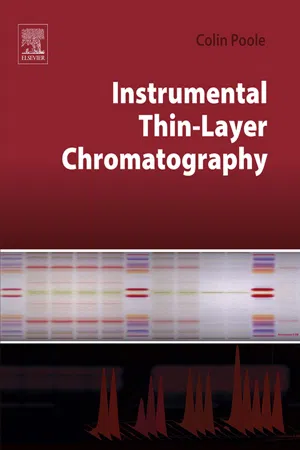
- 652 pages
- English
- ePUB (mobile friendly)
- Available on iOS & Android
Instrumental Thin-Layer Chromatography
About This Book
Instrumental Thin-Layer Chromatography delivers comprehensive coverage of this separation tool with particular emphasis on how this tool can be used in advanced laboratories and integrated into problem-solving scenarios. Significant improvements in instrumentation have outpaced the development of information resources that describe the latest state-of-the-art and demonstrate the full capabilities of TLC. This book provides a contemporary picture of the fundamentals and practical applications of TLC at a level suitable for the needs of professional scientists with interests in project management where TLC is a common tool. Compact, highly focused chapters convey essential information that defines modern TLC and how it can be effectively implemented in most areas of laboratory science. Numerous figures and tables provide access to material not normally found in a single source yet are required by working scientists.
- Contributions written by recognized authoritative and visionary experts
- Focuses on state-of-the-art instrumental thin-layer chromatography and advanced applications across many areas
- Provides guidance on the analysis of complex, dirty mixtures of compounds
- Offers a cost-effective analytic technique for laboratories working under strict budgets
Frequently asked questions
Information
Milestones, Core Concepts, and Contrasts
Abstract
Keywords
Capillary-controlled flow; Column chromatography; Forced flow; High-pressure liquid chromatography; History; Multiple development; Plate height; Plate number; Resolution; Retardation factor; Solvent-strength gradients; Spot capacity; Thin-layer chromatography; Two-dimensional chromatography1.1. Introduction
1.2. Milestones

Table of contents
- Cover image
- Title page
- Table of Contents
- Copyright
- Contributors
- Chapter 1. Milestones, Core Concepts, and Contrasts
- Chapter 2. High-Performance Precoated Stationary Phases
- Chapter 3. Ultrathin and Nanostructured Stationary Phases
- Chapter 4. Automated Multiple Development
- Chapter 5. Forced-Flow Development in Overpressured Layer Chromatography
- Chapter 6. Pressurized Planar Electrochromatography
- Chapter 7. Theory and Instrumentation for In situ Detection
- Chapter 8. Staining and Derivatization Techniques for Visualization in Planar Chromatography
- Chapter 9. Advanced Spectroscopic Detectors for Identification and Quantification: UV—Visible, Fluorescence, and Infrared Spectroscopy
- Chapter 10. Advanced Spectroscopic Detectors for Identification and Quantification: Mass Spectrometry
- Chapter 11. Effects-Directed Biological Detection: Bioautography
- Chapter 12. Solvent Selection and Method Development
- Chapter 13. Validation of Thin Layer Chromatographic Methods
- Chapter 14. Separation of (Phospho)Lipids by Thin-Layer Chromatography
- Chapter 15. Applications in Food Analysis
- Chapter 16. Environmental Applications
- Chapter 17. Pharmaceutical Applications of High Performance Thin Layer Chromatography
- Chapter 18. Utility of Thin-Layer Chromatography in the Assessment of the Quality of Botanicals
- Chapter 19. Analysis of Plant Material
- Chapter 20. Analysis of Dyes and Inks
- Chapter 21. Analysis of Dietary Supplements
- Index